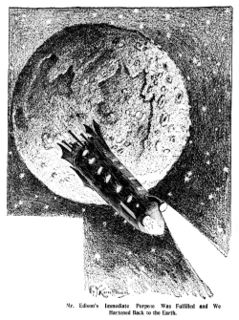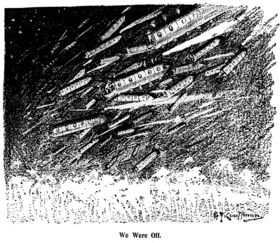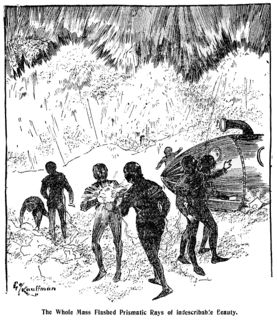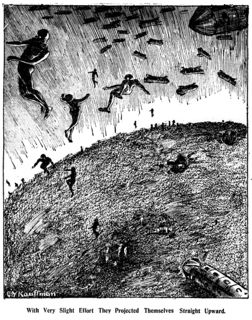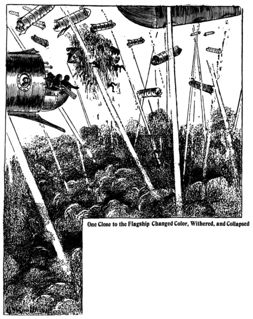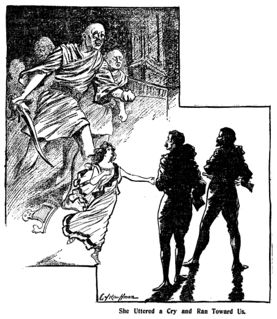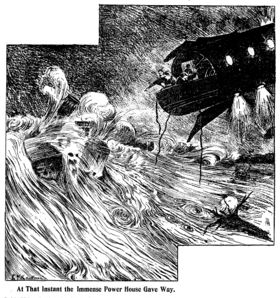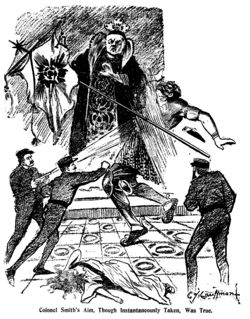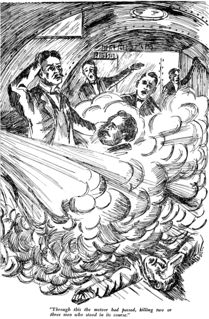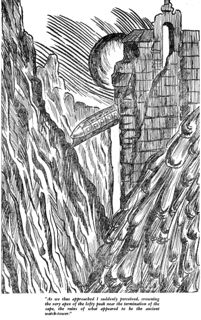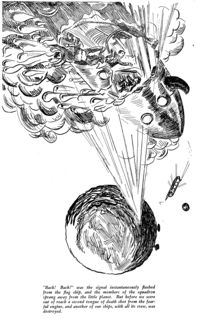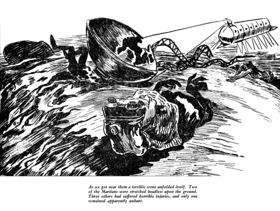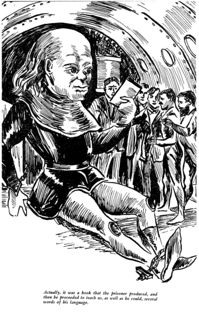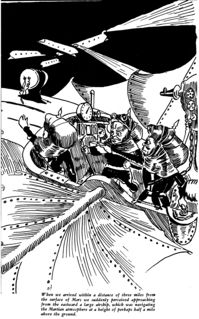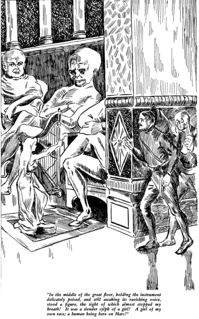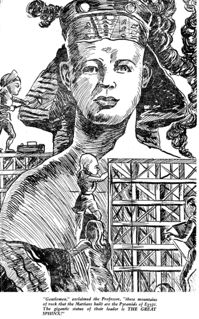Edison's Conquest of Mars (1898 novel)
From Kook Science
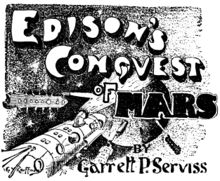 Title art from the 1898 serial ed. | |
| Author | Garrett P. Serviss |
|---|---|
| Illustrator | P. Gray (serial, NY Evening Journal); G. Y. Kauffman (serial, LA Herald); Bernard Manley, Jr. (Carcosa ed.) |
| Pub. date | 1898 (as a serial); 1947 (as a single volume) |
| Language | English |
| Preceded by | Fighters from Mars, or The War of the Worlds (1897) |
Edison's Conquest of Mars is a semi-scientific romance (science-fiction adventure) novel by Garrett P. Serviss that uses then-contemporary public figures as characters, including the titular Thomas Edison, and acts as a sequel to H. G. Wells's War of the Worlds (or, more accurately, the unauthorised revised edition of that novel, serialised as Fighters from Mars), detailing the human response to a failed Martian invasion and the creation by Edison of electrical spaceships and disintegration ray technology to make a retaliatory expedition into space and against Mars itself. The twenty-five chapter story was first serialised by the New York Evening Journal, the Los Angeles Herald, and other newspapers during 1898, only later being republished in a book edition by Carcosa House in 1947.
Synopsis
The final instalment of the serial gave the following as a synopsis, briefly recapping the first twenty-three chapters:
The inventive genius of Thomas A. Edison makes possible an attack of the earth upon Mars. This is done to prevent a second invasion of the Martians, who are trying to relieve their overpopulated planet; the first having failed through the breaking out of disease and not human effort. Edison invents a practical electrical airship, and an engine of destruction called the "Disintegrator" which will cause the constituent particles of any object at which it may be directed to so vibrate that the object will be immediately and completely dispersed. A large fleet of airships armed with disintegrators and manned by two thousand men, among whom are many famous scientists, sets out. The fleet arrived above the land of Hellas, on Mars, and finds a host of airships on the watch. The Martians, who are of giant stature, human in form, but of repulsive aspect, cover their planet with a thick cloud of smoke, which the visitors pierce with their disintegrators. The Martians launch their thunderbolts, and do much damage to the Edison fleet, which finally drops beneath the smoke curtain and engages the enemy, in their ships, in close combat. The destruction is awful both on land and in the air, and the ships from the earth withdraw but sixty in number. The next move is a strategic plan proposed by Colonel Smith, an army officer. The majority of the ships are concentrated at a certain point where the attention of the Martians is held, while a few are sent to the other side of the planet to effect a landing. Colonel Smith's ship descends near a large building. The Colonel and the narrator, entering, are amazed to find a young girl — a human being — playing on a strange instrument for the amusement of several Martians. The latter are quickly dispatched with disintegrators, and the girl is taken hack to the main squadron. Although none can understand the girl, it is perceived that her language is of human origin. The whole squadron repairs to the farther moon of Mars, Deimos, in order to give the linguists of the party time to acquire the girl's speech, for Mr. Edison believes that she can give them information that will lead to a successful routing of the enemy. After three weeks spent on Deimos, out of sight of Mars, the linguists are able to understand Aina's story. Her ancestors were brought from the earth in a previous invasion of the earth by the Martians about 9,000 years ago. From the girl's remarkable narrative it would appear that the Martians had visited Egypt and had built the Pyramids and the Sphinx. Aina's forefathers were carried back to Mars, and they and their descendants had been kept in slavery until, with the exception of Aina, they were all massacred on the arrival of the fleet from the earth. Aina discloses a way by which the Martians can be drowned out. To do this it will be necessary to enter a strongly guarded building which contains the mechanism that controls an artificial disposition of the waters of the oceans and seas of the planet. By turning these into their natural channel the continents will be flooded, because much of the land is below the level of the sea. Returning from Deimos, a party, consisting of the narrator, Mr. Edison, Colonel Smith, Sidney Phillips and Aina, descends near the building and succeeds in accomplishing its purpose. After barely reaching their ship in safety, they watch the oncoming flood that over spreads the land. The Martian forces appear in their airships, but after a short contest they are put to night. The invaders calculate that in two days the waters will reach the land of Thaumasia, the center of population; so they set out to watch the awful destruction that will there take place. As they go they see the Martians fleeing before the flood, but except those who escape in airships and those who are able to reach what slight elevations there are on the time-leveled planet, all go down before the deluge. The waters reach Thaumasia, and the great city on the Lake of the Sun is exterminated.
In the last two chapters of the story, the party of Edison, Smith, Phillips, Aina, and the narrator find the remnants of the ruling military class of Mars, including the Emperor, evacuated to one of the few places on their planet where the deluge would not reach, intending to effect the unconditional surrender of the Martians. There is a brief battle, with the humans again prevailing, and the Martians accept the terms imposed on them. The story closes with an exposition regarding Martian society, including an explanation as to why the Martians ultimately lost the conflict: the lack of certain "peculiar metals" that Edison utilised to create electrical ships and disintegrator rays.
Editions
Newspaper Serial (1898)
- I. Los Angeles Herald (Sunday, February 06, 1898), p. 22, https://chroniclingamerica.loc.gov/lccn/sn85042461/1898-02-06/ed-1/seq-22/
- II. Los Angeles Herald (Sunday, February 06, 1898), p. 22, https://chroniclingamerica.loc.gov/lccn/sn85042461/1898-02-06/ed-1/seq-22/
- III. Los Angeles Herald (Sunday, February 13, 1898), p. 22, https://chroniclingamerica.loc.gov/lccn/sn85042461/1898-02-13/ed-1/seq-22/
- IV. Los Angeles Herald (Sunday, February 13, 1898), p. 22, https://chroniclingamerica.loc.gov/lccn/sn85042461/1898-02-13/ed-1/seq-22/
- V. Los Angeles Herald (Sunday, February 13, 1898), p. 22, https://chroniclingamerica.loc.gov/lccn/sn85042461/1898-02-13/ed-1/seq-22/
- VI. Los Angeles Herald (Sunday, February 20, 1898), p. 22, https://chroniclingamerica.loc.gov/lccn/sn85042461/1898-02-20/ed-1/seq-22/
- VII. Los Angeles Herald (Sunday, February 20, 1898), p. 22, https://chroniclingamerica.loc.gov/lccn/sn85042461/1898-02-20/ed-1/seq-22/
- VIII. Los Angeles Herald (Sunday, February 20, 1898), p. 22, https://chroniclingamerica.loc.gov/lccn/sn85042461/1898-02-20/ed-1/seq-22/
- IX. Los Angeles Herald (Sunday, February 27, 1898), p. 22, https://chroniclingamerica.loc.gov/lccn/sn85042461/1898-02-27/ed-1/seq-22/
- X. Los Angeles Herald (Sunday, February 27, 1898), p. 22, https://chroniclingamerica.loc.gov/lccn/sn85042461/1898-02-27/ed-1/seq-22/
- XI. Los Angeles Herald (Sunday, March 06, 1898), p. 22, https://chroniclingamerica.loc.gov/lccn/sn85042461/1898-03-06/ed-1/seq-22/
- XII. Los Angeles Herald (Sunday, March 06, 1898), p. 22, https://chroniclingamerica.loc.gov/lccn/sn85042461/1898-03-06/ed-1/seq-22/
- XIII. Los Angeles Herald (Sunday, March 06, 1898), p. 22, https://chroniclingamerica.loc.gov/lccn/sn85042461/1898-03-06/ed-1/seq-22/
- XIV. Los Angeles Herald (Sunday, March 13, 1898), p. 20, https://chroniclingamerica.loc.gov/lccn/sn85042461/1898-03-13/ed-1/seq-20/
- XV. Los Angeles Herald (Sunday, March 13, 1898), p. 20, https://chroniclingamerica.loc.gov/lccn/sn85042461/1898-03-13/ed-1/seq-20/
- XVI. Los Angeles Herald (Sunday, March 13, 1898), p. 20, https://chroniclingamerica.loc.gov/lccn/sn85042461/1898-03-13/ed-1/seq-20/
- XVII. Los Angeles Herald (Sunday, March 20, 1898), p. 20, https://chroniclingamerica.loc.gov/lccn/sn85042461/1898-03-20/ed-1/seq-20/
- XVIII. Los Angeles Herald (Sunday, March 20, 1898), p. 20, https://chroniclingamerica.loc.gov/lccn/sn85042461/1898-03-20/ed-1/seq-20/
- XIX. Los Angeles Herald (Sunday, March 27, 1898), p. 23, https://chroniclingamerica.loc.gov/lccn/sn85042461/1898-03-27/ed-1/seq-23/
- XX. Los Angeles Herald (Sunday, March 27, 1898), p. 23, https://chroniclingamerica.loc.gov/lccn/sn85042461/1898-03-27/ed-1/seq-23/
- XXI. Los Angeles Herald (Sunday, March 27, 1898), p. 23, https://chroniclingamerica.loc.gov/lccn/sn85042461/1898-03-27/ed-1/seq-23/
- XXII. Los Angeles Herald (Sunday, April 03, 1898), p. 21, https://chroniclingamerica.loc.gov/lccn/sn85042461/1898-04-03/ed-1/seq-21/
- XXIII. Los Angeles Herald (Sunday, April 03, 1898), p. 21, https://chroniclingamerica.loc.gov/lccn/sn85042461/1898-04-03/ed-1/seq-21/
- XXIV. Los Angeles Herald (Sunday, April 10, 1898), p. 20, https://chroniclingamerica.loc.gov/lccn/sn85042461/1898-04-10/ed-1/seq-20/
- XXV. Los Angeles Herald (Sunday, April 10, 1898), p. 20, https://chroniclingamerica.loc.gov/lccn/sn85042461/1898-04-10/ed-1/seq-20/
Illustrations
New York Evening Journal
The original newspaper illustrations by P. Gray.
- http://freeread.com.au/@RGLibrary/GPServiss/EdisonsConquestOfMars.html (12 Jan. - 10 Feb. 1898)
Los Angeles Herald
The original newspaper illustrations by G. Y. Kauffman.
Book (1947)
- Serviss, Garrett P.; Searles, A. Langley (1947), Edison's Conquest of Mars, Los Angeles: Carcosa House, https://catalog.hathitrust.org/Record/011719755
Illustrations
The Carcosa House book edition illustrations by Bernard Manley, Jr., based on the original illustrations by P. Gray from the New York Evening Journal serial edition.
